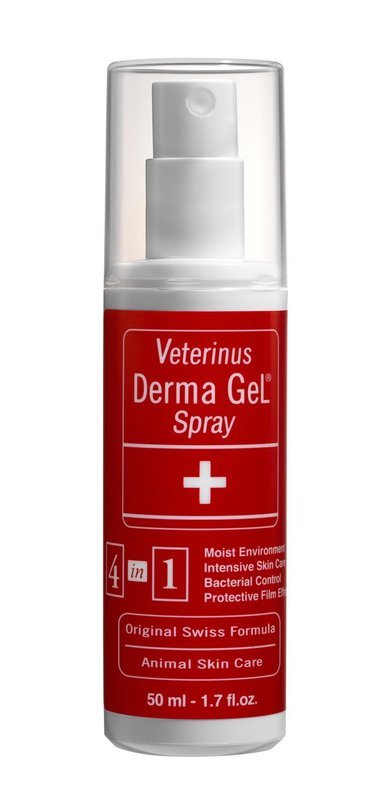Derma GeL®- Spray
Derma GeL® - The most trusted wound care product worldwide.
Derma GeL® is an isotonic hydrogel made of high-molecular-weight polymers that promotes wound healing in all animal species: horses, dogs, cats, livestock, birds, reptiles and exotics.
Derma GeL® ensures: bacteriostatic properties, moist environment, soothing effect, healing process enhancers, insect repellent feature and a protective layer (no secondary dressing or bandage required). The unrivaled efficacy of this combination reduces drastically the healing time by 60% leading to fewer product applications.
The Healing Process
Derma GeL® provides a moist environment which maintains epithelial cell viability to 97% [2] and enables healing epithelial cells to migrate across the wound bed, multiply exponantially and enhance wound healing - increasing wound contraction speed.
The moist environment provided by Derma GeL® does not permit the formation of a scab. These properties promote wound healing from the sides as well as the bottom of the wound.
A wound without moisture will form a scab. In order to heal, the epithelial cells have to migrate below the scab to reach moisture that enables them to heal the wound. Epithelial cells that have to migrate longer distances do not survive well, and this delays wound healing.
Infection Rate
All wounds are contaminated with microorganisms. The difference between a contaminated wound and an infected wound is the concentration of microorganisms present in the wound. Proper cleansing and care of the wound will prevent the number of microorganisms from increasing to the point of infection. It is recommended that the wound be flushed generously with saline solution or warm water. The use of topical antibiotics is not recommended with Derma GeL®. The protective layer and bacteriostatic properties provided by Derma GeL® enable the wound to heal without bandaging while controlling bacterial proliferation.
No Bandaging Required
The conventional method of wound treatment involved applying gauze and wraps which were thought to protect the wound and speed up healing. Wounds covered with a hydrogel dressing are kept moist without the need for bandaging. Therefore, the skin heals faster, without the trauma of bandage removal and replacement.
When Derma GeL® is applied, it provides an external layer of protective film. This external layer is semi-occlusive and enables the inner layer to maintain a moist environment. The moist environment is composed of hydrophilic particles and several active molecules, which absorb exudates from the wound.[1],[3] The combination of the protective film and the ability to absorb wound exudate creates an optimal moist environment for rapid healing..[4] ,[5]
No Excessive Tissue Granulation or Hair Discoloration
The use of Derma GeL® with proper wound cleansing minimizes microbacterial concerns that the microorganism population will not increase to infection levels, and that exudates are absorbed from the wound, providing a moist environment in which the healing epithelial cells can work to heal the wound. When keeping the wound cleansed and moist, the epithelial cells produced are identical to those prior to the damage. Derma GeL® does not contain any mutagenic agents, which induce the formation of excessive tissue granulation and discolored hair on regrowth.
References
- Mertz PM. Intervention: dressing effects on wound healing. In: Eaglstein WH, ed. Wound Care Manual: New Directions in Wound Healing. Princeton, NJ: ConvaTec; 1990:83-96.
- Vandenbosch, A Coquette-Biopharma-Maximillian Zenho & Co - Assessment of the product Derma GeL® on a 3-dimensional in vitro skin model. Analytical Report No 197508-March 1997.
- Mellion MB, Fandak DM, Wagner WF, Kwikkel MA. Hydrocolliod dressings in the treatment of turf burns and other athletic abrasions. Athl Train, JNATA. 1988;23:341-346.
- Rose, R.J., Hodgson D.R., W.B. Saunders - Manual of Equine Practice - Dermatology, Skin Wounds, 1993, p. 340-341
- Hermans MH. Clinical benefit of a hydrocolloid dressing in closed surgical wounds. J Enterostom Nurs. 1993;20:68-72.
OUR STORE
Address: 306 JJ Thiessen Way Saskatoon, SK S7K 5P4
Phone: 306.361.3259
Email: sales@stargazerexotics.ca
Call Us Now! 306-361-3259
HELP
OPERATING HOURS
We are a home-based online business. Our online store is open 24 hours a day.
© 2016-2024 by Stargazer Exotics

